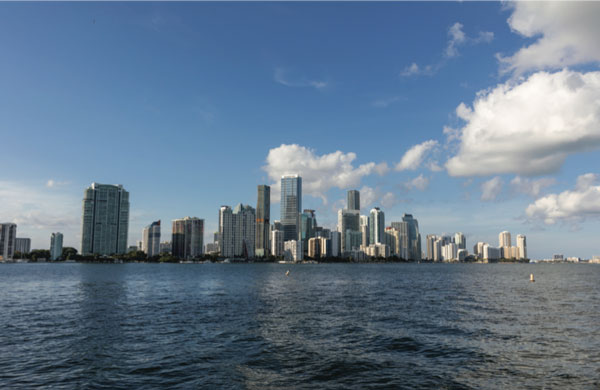
4 minute read
Leading the Charge in Nature-based Solutions: Miami-Dade CSRM Pioneering Pilot Program
from America's Engineers: The People, Programs, and Projects of the U.S. Army Corps of Engineers '24-'25
BY BREEANA HARRIS
NORTH ATLANTIC DIVISION Norfolk District
In a landmark move that could redefine coastal storm risk management, the U.S. Army Corps of Engineers (USACE) Norfolk District, in collaboration with Miami-Dade County, is spearheading the first-ever Nature-based Solutions (NBS) Pilot Program for the Miami-Dade Coastal Storm Risk Management (CSRM) Feasibility Study.
This groundbreaking initiative, set to be proposed to Congress, shifts the paradigm of traditional risk management via structural or “gray” infrastructure by prioritizing nature-based methods, setting a new standard for resilience and environmental stewardship. Historically, USACE has faced challenges in advancing nature-based solutions due to performance-focused technical analyses favoring traditional structures like surge gates and pump stations.
However, the success of this novel pilot program underscores a pivotal transformation, made possible by extensive public engagement and collaborative efforts. The voices of the community have been instrumental in shaping this initiative, demonstrating a commitment to solutions that reflect both engineering expertise and environmental sustainability.

“Listening to the community and incorporating their feedback has been a crucial part of establishing what this program could look like and accomplish,” said Abbegail Preddy, project manager for the Miami-Dade Back BY BREEANA HARRIS
Bay CSRM Study at Norfolk District. “The Nature-Based Solutions Pilot Program showcases how we can blend innovative traditional engineering with nature-based solutions to enhance resilience and manage risk to our coastal systems in a way that serves the Miami-Dade community and environment while also benefiting future communities and USACE feasibility studies.”
advertisement

The NBS Pilot Program aims to explore, implement, and monitor a variety of natural projects to inform USACE’s technical tools and ability to advance more nature-based and/or hybrid green/gray infrastructure across the nation. These strategies are designed to mitigate storm surge damage to vulnerable populations while promoting and prioritizing ecosystem health, providing dual benefits for both community resilience and environmental sustainability.
Additionally, the NBS Pilot Program will study storm surge damage reduction and the long-term level of performance and risk man- agement of individual pilot projects, which will enhance USACE’s ability to apply these solutions in other CSRM studies that serve vulnerable communities and regions.
Additionally, the NBS Pilot Program will study storm surge damage reduction and the long-term level of performance and risk management of individual pilot projects, which will enhance USACE’s ability to apply these solutions in other CSRM studies that serve vulnerable communities and regions.5
The proposed Nonstructural Pilot Study is another trailblazing initiative focused on investigating an expanded portfolio of nonstructural solutions where existing USACE implementation practices are still developing. For example, many vulnerable people in Miami-Dade County, including the economically and socially disadvantaged communities, live in multifamily housing such as apartments or condos, where USACE has limited experience applying nonstructural measures such as elevations or floodproofing. This study aims to expand the USACE nonstructural toolkit for future feasibility studies by developing and implementing nonstructural measures for multifamily and other unique buildings that are often just as vulnerable and at risk to coastal storm damage as single-family residential housing.
Preddy emphasized the importance of collaboration in achieving this milestone.
“The success of the NBS Pilot Program is a direct result of our collaborative engagement process, and of leadership within USACE aiming to think outside the box of existing policy or implementation limitations. By incorporating stakeholder, resource agency, and community feedback, we have developed a program for Congress to write into law that will aim to addresses storm surge risks while aligning with the broader environmental goals of Miami-Dade. This approach demonstrates how engineering and ecological considerations can be effectively integrated.”
The introduction of the NBS Pilot Program marks a significant evolution in coastal storm risk management, reflecting a growing recognition of the value of nature-based solutions alongside more typical hardening engineering methods. Miami-Dade County and USACE are setting a new precedent in resilience planning, paving the way for future advancements in integrated coastal management strategies.
The chief’s report for the Miami-Dade CSRM Feasibility Study is anticipated to be signed at the end of August 2024, which would allow for these transformative initiatives to be authorized by Congress potentially as soon as the Water Resources Development Act of 2024. AE
—
Visit www.Americas-Engineers.com to sign up for a free print edition of our annual publication and to join our weekly newsletter.










